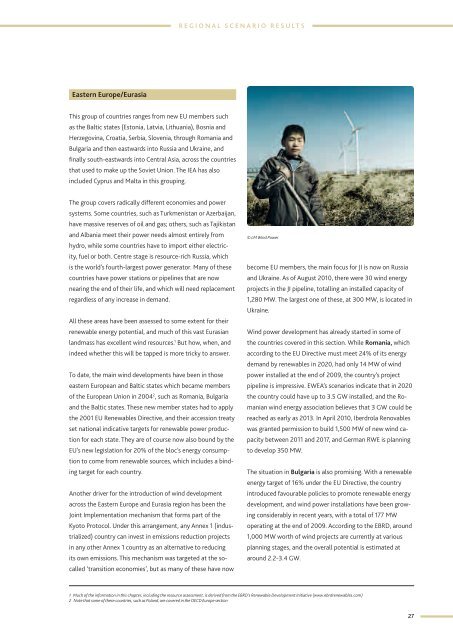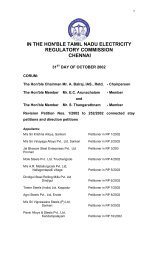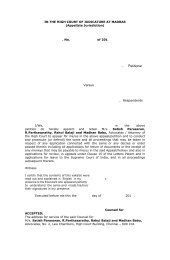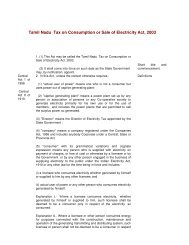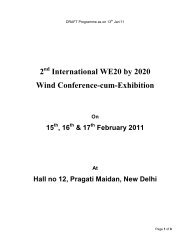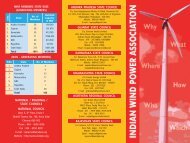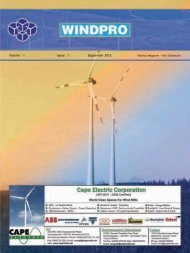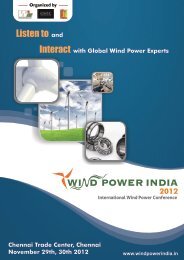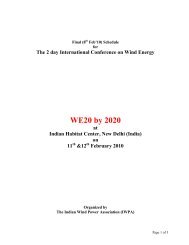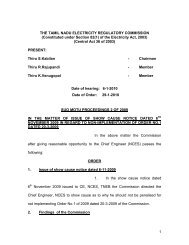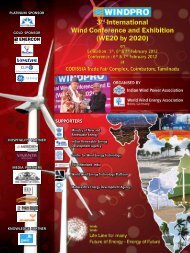glOBal Wind energy OuTlOOk 2010 - Global Wind Energy Council
glOBal Wind energy OuTlOOk 2010 - Global Wind Energy Council
glOBal Wind energy OuTlOOk 2010 - Global Wind Energy Council
Create successful ePaper yourself
Turn your PDF publications into a flip-book with our unique Google optimized e-Paper software.
R e g i o n a l s c e n a r i o r e s u l T S<br />
Eastern Europe/Eurasia<br />
This group of countries ranges from new EU members such<br />
as the Baltic states (Estonia, Latvia, Lithuania), Bosnia and<br />
Herzegovina, Croatia, Serbia, Slovenia, through Romania and<br />
Bulgaria and then eastwards into Russia and Ukraine, and<br />
finally south-eastwards into Central Asia, across the countries<br />
that used to make up the Soviet Union. The IEA has also<br />
included Cyprus and Malta in this grouping.<br />
The group covers radically different economies and power<br />
systems. Some countries, such as Turkmenistan or Azerbaijan,<br />
have massive reserves of oil and gas; others, such as Tajikistan<br />
and Albania meet their power needs almost entirely from<br />
hydro, while some countries have to import either electricity,<br />
fuel or both. Centre stage is resource-rich Russia, which<br />
is the world’s fourth-largest power generator. Many of these<br />
countries have power stations or pipelines that are now<br />
nearing the end of their life, and which will need replacement<br />
regardless of any increase in demand.<br />
All these areas have been assessed to some extent for their<br />
renewable <strong>energy</strong> potential, and much of this vast Eurasian<br />
landmass has excellent wind resources. 1 But how, when, and<br />
indeed whether this will be tapped is more tricky to answer.<br />
To date, the main wind developments have been in those<br />
eastern European and Baltic states which became members<br />
of the European Union in 2004 2 , such as Romania, Bulgaria<br />
and the Baltic states. These new member states had to apply<br />
the 2001 EU Renewables Directive, and their accession treaty<br />
set national indicative targets for renewable power production<br />
for each state. They are of course now also bound by the<br />
EU’s new legislation for 20% of the bloc’s <strong>energy</strong> consumption<br />
to come from renewable sources, which includes a binding<br />
target for each country.<br />
Another driver for the introduction of wind development<br />
across the Eastern Europe and Eurasia region has been the<br />
Joint Implementation mechanism that forms part of the<br />
Kyoto Protocol. Under this arrangement, any Annex 1 (industrialized)<br />
country can invest in emissions reduction projects<br />
in any other Annex 1 country as an alternative to reducing<br />
its own emissions. This mechanism was targeted at the socalled<br />
‘transition economies’, but as many of these have now<br />
© LM <strong>Wind</strong> Power<br />
become EU members, the main focus for JI is now on Russia<br />
and Ukraine. As of August <strong>2010</strong>, there were 30 wind <strong>energy</strong><br />
projects in the JI pipeline, totalling an installed capacity of<br />
1,280 MW. The largest one of these, at 300 MW, is located in<br />
Ukraine.<br />
<strong>Wind</strong> power development has already started in some of<br />
the countries covered in this section. While Romania, which<br />
according to the EU Directive must meet 24% of its <strong>energy</strong><br />
demand by renewables in 2020, had only 14 MW of wind<br />
power installed at the end of 2009, the country’s project<br />
pipeline is impressive. EWEA’s scenarios indicate that in 2020<br />
the country could have up to 3.5 GW installed, and the Romanian<br />
wind <strong>energy</strong> association believes that 3 GW could be<br />
reached as early as 2013. In April <strong>2010</strong>, Iberdrola Renovables<br />
was granted permission to build 1,500 MW of new wind capacity<br />
between 2011 and 2017, and German RWE is planning<br />
to develop 350 MW.<br />
The situation in Bulgaria is also promising. With a renewable<br />
<strong>energy</strong> target of 16% under the EU Directive, the country<br />
introduced favourable policies to promote renewable <strong>energy</strong><br />
development, and wind power installations have been growing<br />
considerably in recent years, with a total of 177 MW<br />
operating at the end of 2009. According to the EBRD, around<br />
1,000 MW worth of wind projects are currently at various<br />
planning stages, and the overall potential is estimated at<br />
around 2.2-3.4 GW.<br />
1 Much of the information in this chapter, including the resource assessment, is derived from the EBRD’s Renewable Development Initiative (www.ebrdrenewables.com)<br />
2 Note that some of these countries, such as Poland, are covered in the OECD Europe section<br />
27


